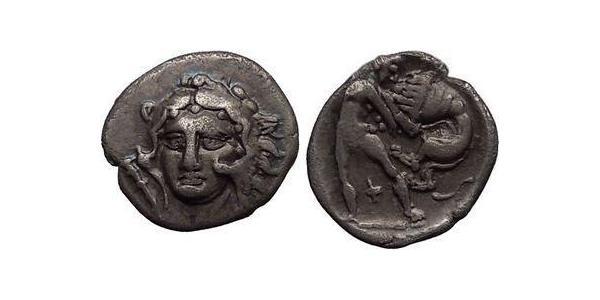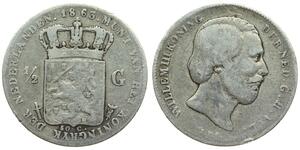[ 4353] CALABRIA: TARENTUM Silver Diobol (13mm, 1.13 gm.) Struck c.390 B.C. Excellent artistic style. Superb and Very Rare. Reference: HN Italy 977; Vlasto Coll.1348. Head of Heracles facing, wearing lion skin head-dress. Heracles strangling the Nemean lion - "First Labor." Provided with certificate of authenticity. CERTIFIED AUTHENTIC by Sergey Nechayev, PhD - Numismatic Expert The First Labor of Hercules Hercules slaying the Nemean lion. Detail of a Roman mosaic from LlÃria (Spain). The first of Hercules' twelve labours, set by King Eurystheus (his cousin) was to slay the Nemean lion and bring back its pelt. According to Greek myth, the Nemean lion took hostages to its home in a cave near the city of Nemea, luring warriors from nearby towns to save the damsel in distress. After entering the cave, the warrior would see the woman (usually feigning to be injured) and rush to her side. Once he was close, the woman would transform into the lion and kill the warrior, devouring his remains and giving the bones to Hades. Heracles wandered the area until he came upon the town of Cleonae. There he met a boy who said that if Heracles slew the Nemean lion and returned alive within 30 days, the town would sacrifice a lion to Zeus; but if he did not return within 30 days or he died, the boy would sacrifice himself to Zeus. While searching for the lion, Heracles fletched arrows to use against it, not knowing that its golden fur was impenetrable; upon finding the lion and firing at it with his bow, he deduced the fur's protective property when the lion would not die. After some time, Heracles made the lion return to his cave. The cave had two entrances, one of which Heracles blocked; he then entered the other. In those dark and close quarters, Hercules stunned the beast with his club and strangled it. Finally, because no mortal weapon could pierce the golden fur, Heracles used the lion's own claws to skin the pelt. Another version of the legend that says that Heracles to shot it with arrows, and eventually shot it in the throat, killing it. When he returned to the King, King Eurystheus was shocked. He gave Heracles the lion's invincible pelt to wear as a cloak, but warned Hercules that the tasks set for him would become increasingly difficult. He then sent Heracles off to complete his next quest, which was to destroy the Lernaean hydra.. Heracles completed this task over the course of three months when he was eighteen years old. ------------------------------------------------------------------------------------------------------------------- Taranto was founded in 706 BC by Dorian Greek immigrants as the only Spartan colony, and its origin is peculiar: the founders were Partheniae, sons of unmarried Spartan women and Perioeci (free men, but not citizens of Sparta); these unions were permitted by the Spartans to increase the number of soldiers (only the citizens of Sparta could become soldiers) during the bloody Messenian wars, but later they were nullified, and the sons were forced to leave. Phalanthus, the parthenian leader, went to Delphi to consult the oracle: the puzzling answer designated the harbour of Taranto as the new home of the exiles. The Partheniae arrived in Apulia, and founded the city, naming it Taras after the son of the Greek sea god, Poseidon, and of a local nymph, Satyrion. According to other sources, Heracles founded the city. Another tradition indicates Taras as the founder of the city; the symbol of the Greek city (as well as of the modern city) depicts the legend of Taras being saved from a shipwreck by riding a dolphin that was sent to him by Poseidon. Taranto increased its power, becoming a commercial power and a sovereign city of Magna Graecia, ruling over the Greek colonies in southern Italy. Its independece and power came to an end as the Romans expanded throughout Italy. Taranto won the first of two wars against Rome for the control of Southern Italy: it was helped by ...
type to read more

|
Posted by:
anonymous 2015-08-19 |
Similar Coin Groups
2025-05-29
- New coin is added to 50 Cent / 1/2 Gulden Kingdom of the Netherlands (1815 - ) Si ...
50 Cent / 1/2 Gulden Kingdom of the Netherlands (1815 - ) Si ...
group has 13 coins / 13 prices
⇑
Netherlands - Gulden 1863 - Silver
2025-05-24
- New coin is added to 1 Liard Belgium Copper
1 Liard Belgium Copper
group has 4 coins / 4 prices
⇑
Austrian Netherlands - Liard 1790 - Head
You may be interested in ...














-300-150-IHcKbzbizFcAAAFRpvtauxkd.jpg)








